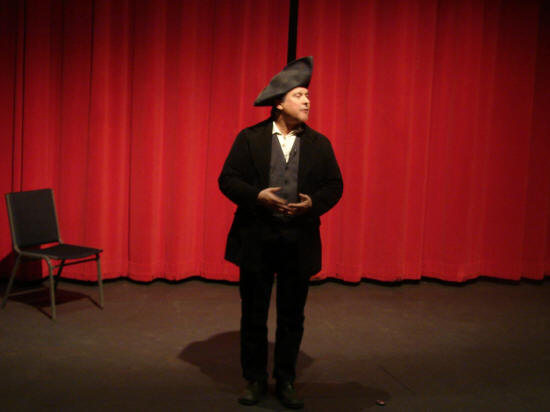|
 Ellis developed a program about Ninian Edwards and
Chief Como of the Pottawatomie Tribe who both made vital
contributions to Illinois and the United States. Yet, each is little
known. Ellis developed a program about Ninian Edwards and
Chief Como of the Pottawatomie Tribe who both made vital
contributions to Illinois and the United States. Yet, each is little
known.
Ellis said, “It took me about a year of research to develop this
presentation about Ninian Edwards and Chief Como. I did it
originally for the bicentennial of the War of 1812, but it seems
especially appropriate for the celebration of the Illinois
Bicentennial on December 3, 2018.” “Both men had a profound impact
on Illinois yet each is not given his due for what they did. It is
my intention to correct that,” he added.

Brian Ellis portrays Ninian Edwards,
Territorial and later State Governor of Illinois.
Born in the 18th century, Ninian Edwards came from a
wealthy Maryland family and seemed to be on his way to success on
the east coast. But as with most lives, his took a radical change
when he was sent to Kentucky to oversee his family’s property and to
purchase more. There, as a young man, he became notorious, more for
his partying than his business acumen. At some point, he came to his
senses and reformed, going on to complete law school and becoming a
respected member of the Kentucky bar. He even was appointed Chief
Justice of the Kentucky Supreme Court at a young age.

All of his successes came to the attention of national leaders who
saw in him a potential leader for the territories along the
Mississippi River.
President James Madison with a recommendation by Henry Clay
appointed Ninian Edwards to be Governor of the Illinois Territory, a
time before statehood. Edwards oversaw the creation of a state out
of a wild territory from his office in Kaskaskia. The territory was
surveyed, a territorial government was organized, and one of the
most important products of the nascent state was developed, the
mining of salt. Yes, Illinois was known for its abundance of salt, a
vital part of the preindustrial way of life. Edwards achieved great
success as the Illinois territorial governor, even shepherding
Illinois to statehood in 1818, even before it had the requisite
population for statehood. But he is known for his participation in a
notorious event that took place in 1812 in the territory.
Brian Ellis tells the story of a meeting between Ninian Edwards and
Pottawatomie Chief Como in the summer of 1812 in southern Illinois
at Cahokia.

Ellis portraying Pottawamie Chief
Como.
Chief Como was a leader of the Pottawatomie nation
but was so well respected by the chiefs of thirty-four tribes that
he was chosen a spokesman for them.
And what was the purpose of the meeting between
Edwards and Como?
The white settlers of Illinois had accused the Indians of atrocities
and wanted a resolution of the Indian “problem” in the territory.
During the three day meeting at Cahokia, Edwards
spoke of the murders of settlers by Indians. He wanted the Indians
turned over to the white territorial government for justice to be
done.
[to top of second column] |

Chief Como countered that his tribes had always had a peaceful
relationship with the white settlers and had no knowledge of the perpetrators of
the crimes. He stated that if the tribes knew who was responsible, they would be
brought to justice under native laws.
Edwards accused the Indians of conspiring with the British in the War of 1812.
Chief Como reiterated that the Pottawatomie had not sided with the British in
the Revolutionary War and were not helping them in the War of 1812. Como even
pointed out that his tribe had fed and assisted starving white settlers who were
moving into Illinois and occupying traditional Indian hunting and farming
ground. He accused Edwards and the territorial government and the United States
of disrespecting Indian laws and land.
There was no resolution of grievances during the three days. Each side accused
the other of bad faith.
In a startling turn of events, Ninian Edwards gathered a militia and marched to
the French and Pottawatomie Village of Peoria and attacked it, killing French
settlers and Indian women and children who were there to trade, and destroying
crops on the surrounding farms.
The Indian warriors were residing in the village of Chillicothe, farther north
on the Illinois River. Chief Como’s wife and children were killed in the attack.
French settlers were accused of conspiring with the British in the War of 1812.
There was no truth to this falsehood. The massacre is one little known part of
the history of Illinois, almost totally forgotten in the hoopla of the state’s
bicentennial celebration.
Thus began the expulsion of the Indian population from Illinois. One little
known result of the Peoria massacre is that the French residents who survived
the attack sued the United States government for damages. The case wound through
the courts for decades. One central Illinois lawyer to take up the case for the
descendants of the French who were killed at Peoria was Abraham Lincoln.
Brian Ellis portrayed both Ninian Edwards and Chief Como in his presentation,
dressing the part of each man. “I wanted to portray the voice of each side in an
evenhanded manner,” said Ellis.
Ellis used the actual words of each man that were spoken at the Cahokia meeting.
“I found this a difficult task as I am part Cherokee, and the Cahokia meeting
and Peoria massacre were precursors by many years of the infamous Trail of Tears
instituted by President Andrew Jackson in the 1830’s, part of which winds
through southern Illinois,” he said.

Brian Ellis has been giving his presentation of the meeting between Ninian
Edwards and Chief Como almost every day during November. He has also developed a
special presentation on the Trail of Tears that he has performed in the towns
that line the Trail in southern Illinois.
Brian Ellis is a master storyteller, performer, and historian who has dedicated
his life to bringing history alive. He gives history a vibrancy that cannot be
duplicated by reading a book in a classroom.
“It is often said that history has two sides and we need to listen to both. A
true historian says that history has more than two sides, many, many sides and
we need to study and learn from all of them. That is my mission. I want people
to discuss what they hear in my performance,” he said.
Check the Lincoln Heritage Museum’s website and Face Book page for upcoming
presentations on the history of Illinois, or contact Anne Mosely, director of
the museum at 217-735-7347.
[Curtis Fox] |